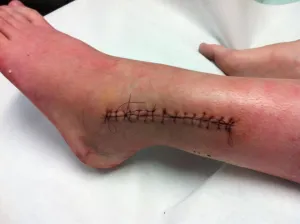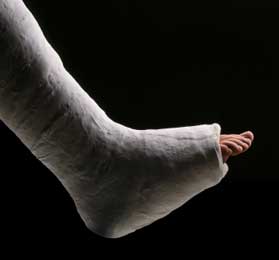Maybe it’s just bad timing. Maybe it’s just bad luck. Maybe the stars have aligned in an unfavourable way, but something is up with my derby peeps these days.
They all seem to be breaking their bones. No joke – 3 people that I know personally all had ankle or tib/fib breaks within a week of each other.
According to this 2012 post from one of the MRD skaters, ankle breaks are pretty common in Wisconsin, with a break happening “every couple of months.” Not fun, but certainly not out of the ordinary for any given derby league. Often, these breaks result in surgery and lengthy recovery time.
Was this rash of breaks a weird coincidence? Probably. Super unfortunate for all of the skaters? Certainly. Systemic problem in the way that we’re teaching derby skaters to stride, fall, and recover? Perhaps. League-level problem in fatigue management and safety protocols? Heck, could be that too.
I’ve been giving knee and ankle injuries a great deal of thought since these breaks went down. As head of training for my league, I care deeply about the safety of our skaters and I don’t ever want to be teaching things that knowingly put girls in harm’s way – other than all of the slamming into each other. Derby is a full-contact sport and injuries are going to happen, we all know that. Having said it though, we need to evaluate if there are preventable factors that we’re ignoring that are resulting in these kinds of injuries. Is falling on our knees, or trying to tuck our feet beneath us (as in a baseball slide) the best course of action – sure we’re falling small – but are we falling safely?
 Back when I started writing this blog, I asked if maybe we could be doing better things for our knees (after seeing a crazy run of knee ligament injuries in our league). I’m not alone in wondering if what we’re teaching is doing us more harm than good, Mercy Less posed some wonderful questions about it 2011 and Punchy O’Guts wrote a beautiful article in April that I read and re-read all the time.
Back when I started writing this blog, I asked if maybe we could be doing better things for our knees (after seeing a crazy run of knee ligament injuries in our league). I’m not alone in wondering if what we’re teaching is doing us more harm than good, Mercy Less posed some wonderful questions about it 2011 and Punchy O’Guts wrote a beautiful article in April that I read and re-read all the time.
I think Mercy is totally on point when she asks, “Who decided we have to fall on our knees in derby in the first place? Why? What criteria was used in this decision? Who tested this idea?”
The likely answer is we made it up ourselves (with heavy borrowing from skateboarding), and shared what worked best for us at the time. Don’t get me wrong, one of the lovely things about roller derby is the open sharing of tools and information – but 10+ years later we still haven’t, as a whole, looked outside of our little community to really examine the science of roller derby and the long-term effects of the skills that we teach, nor have we come to a consensus about how to keep ourselves safer. The new WFTDA minimums are getting better (knee taps instead of knee falls, no baseballs or suicides), but we’re still teaching girls to fall small and use their knees. Why? We’re still teaching falling drills, period. Why?
After reading Punchy’s article (a million times), where she asks if other sports teach falling, I too tried to find examples of falling drills in any other sport training, and came up with nothing. The closest I got was this video, which is not a fall at all, but rather a resistance of falling.
Obviously every break, sprain, strain, and tweak is different, and we ARE going to fall. Maybe if we stop teaching (perhaps injurious) falling tactics and let skaters fall naturally in ways that their minds deem safe in the moment, we could avoid some nasty injuries. Our brains are magnificent things and will try to protect us in sticky situations.
HOWEVER, derby is a team sport, and the safety of the other skaters on the track needs to be taken into consideration as well. I remember the firestorm when Atom first released their small profile pads. The derby-verse was awash with criticism of the sprawling, which is the norm for speed skaters (and artistic skaters, and soccer and volleyball players, and so on). People said, ‘we’re not speed skaters, we can’t fall that way, think of the other skaters we’ll be kicking the feet out from under’. Which are all valid concerns. But football, hockey, and rugby players get hit and fall, and they all sprawl or roll, trusting that their teammates are skilled enough to navigate around them. They have a little more space to work with than we do, sure, but we can’t ignore that virtually no other sport advises that athletes “take a knee”. Then again, this is just me borrowing ideas from other sports again – what we really need are some facts of our own.
Here’s what I think is the most important part of what Punchy has to say:
“I think falling drills are counterproductive. I know of several skaters who, when blocked or start to lose their balance, default to falling instead of trying to stay up. I think this happens because the muscle memory says it’s time to fall, rather than find your balance! spin out of it! use the momentum! If those skaters had more balance training and less falling drills, I think they would spend less time kissing the floor and more time as an effective teammate.”
BAM.
YES.
More Stumbling, Less Falling
Punchy outlines some awesome balance drills in her post. Here are some more that we’ve started to incorporate at our league:
Partner Perturbations: Get into partners. One partner stands on one foot, maintaining her balance. The other partner pushes, pokes, and prods (safely) from all angles. Balancing partner uses her core to stay upright. Perturb for 30-60s, then switch legs. You can do thing moving or stationary.
Sumo Fights: Also in partners. Partner pairs spread themselves out on the track, each on one side of a line (this works best when the line is not raised – you can also do this with painted lines in a hockey arena). Partners lean heavily on each other trying to push their way over the line while moving forward. Coach skaters to keep their supporting leg underneath them, use their glutes and abs to push, and not to rely solely on upper body. Push for 30-60s, then switch sides. This drill is not about aggression – it’s about controlling your body – no hitting, just even pressure.
In addition, let’s teach more avoidance, agility, and awareness, so that falling skaters are less of a hazard.
Balance drills are a part of the solution. Offskates warm-ups are a part of the solution. Sound strength and conditioning are a part of the solution. Examining the way that we teach (or don’t teach) falling is part of the solution. Encouraging skaters to take FULL recovery is a part of the solution since the greatest predictor of future injury is previous injury.
Managing the fatigue level of skaters at practice is another component. Especially in the summer, when attendance levels can be lower than usual, we need to be careful not to over-do it, and allow sloppy drills and scrimmaging. Sure, injuries can happen any time of year under any circumstances, but if numbers are low and fatigue is high, high-risk drills might not be the best practice.
Reaching out to experts in this sort of thing is also a part of the solution – as a community we need to be less afraid to ask for professional help when we need it.
We need to spend less time fussing over the tiny details that we love to fight about – who’s eligible or not eligible for Champs, whether jammer penalties and passive offence breaks derby – and more time seeking out answers to the big questions – how this sport actually affects our bodies both short and long term, how we can keep our skaters the safest while maintaining the excitement and spirit of the sport.
I love you, roller derby, but I don’t love when you break my friends. Let’s work on it.
Got a break? In recovery? Here are some resources that might help you:
Roller Derby Athletics – How To Survive a Derby Injury






